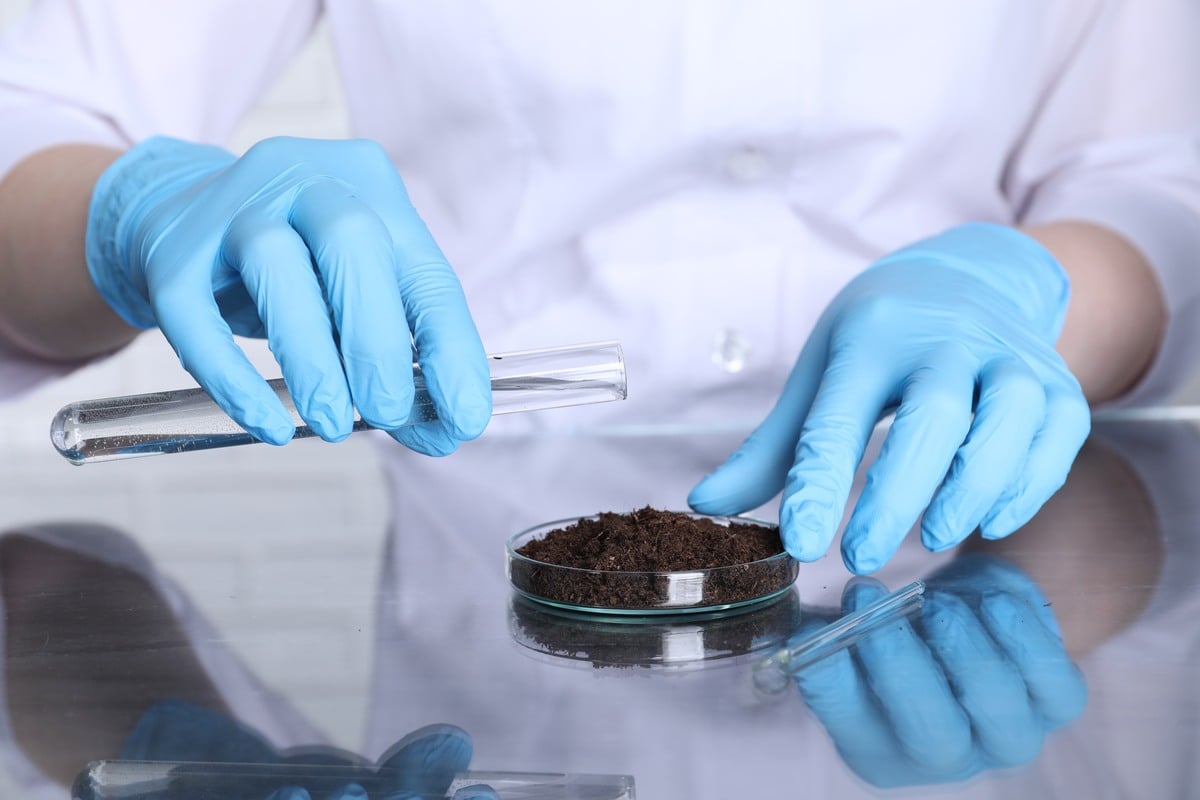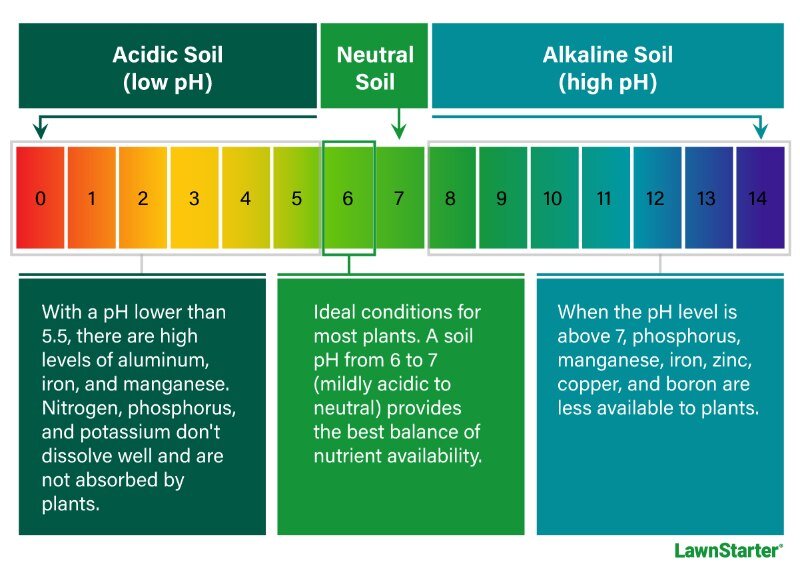
What lies underground holds the key to your lawn’s success, and soil testing reveals these insights. This guide breaks down essential analyses — pH levels, nutrient content, and others — helping you read a soil test report and interpret the data.
Rest assured, this is one test that doesn’t require studying. Having analyzed hundreds of soil samples during my graduate studies, this stuff is ingrained in my brain, and I’ll help guide you through the process.
What is a Soil Test, and Why is it Important?
Soil analysis provides a detailed breakdown of your soil’s chemical makeup and overall condition. This process offers invaluable information on the underground environment affecting your lawn.
I compare soil testing to getting lab work done during a medical checkup. The results reveal critical information and highlight potential issues so that you can customize your turf management specifically for your situation. A targeted strategy helps prevent problems such as pH imbalances and nutrient shortages that lead to poor grass growth and susceptibility to lawn disease.
For more in-depth reasons why you should routinely test your soil, check out: “9 Reasons Why Soil Testing Is Important for the Lawn.”
Have an expert read your soil’s lab results. Hire a local lawn fertilization service to apply just the right nutrients (at the right time) for a healthy lawn.
Understanding the Analyses in Your Soil Test Report
Your soil test report may look slightly different depending on the lab performing the analysis, but the content is typically very similar, no matter where you send your sample.
Soil pH
In most cases, the first value you’ll see on your soil test report is soil pH, which quantifies the hydrogen ions (H+) found in the soil. This pH reading matters significantly because it directly affects how your grass and plants can access nutrients.
pH values span from 0 to 14, with 7.0 representing neutral conditions. Target a lawn soil pH from 6.0 to 7.0 (mildly acidic to neutral) for the best nutrient availability and uptake.

Extreme pH levels — too acidic or alkaline — can lock up essential nutrients, creating deficiency issues, or make them overly available, leading to toxic levels.
Pro Tip: pH operates on a logarithmic scale, meaning each whole number represents a ten-fold difference in acidity. A pH of 6.0 is ten times more acidic than pH 7.0, and one hundred times more acidic than pH 8.0.
Adjusting Your Soil pH
When your soil pH is outside of the ideal range, your soil test report will specify the pounds of soil amendment needed per acre to adjust it. Typically, you’ll apply limestone to increase pH and sulfur to decrease it.
See Related:
- How Soil pH Affects Lawn Health
- How to Test the Soil pH of Your Lawn
- When to Test the Soil pH of Your Lawn
- How to Change Your Soil pH
- Lime for Lawns: Why, When, and How to Lime a Lawn
Plant Essential Nutrients
Like humans require vitamins, plants depend on specific nutrients for growth. These plant essential elements are classified into 3 groups according to how much plants require:
- Primary nutrients: Nitrogen (N), phosphorus (P), and potassium (K)
- Secondary nutrients: Magnesium (Mg), calcium (Ca), and sulfur (S)
- Micronutrients: Boron (B), zinc (Zn), iron (Fe), manganese (Mn), chlorine (Cl), copper (Cu), molybdenum (Mo), and nickel (Ni)
Primary and secondary nutrients are required in larger amounts and typically appear as percentages or parts per million. These macronutrients are the cornerstone of plant nutrition, and deficiencies rapidly cause stunted growth and yield problems.
While micronutrients are just as important as macros for plant growth, they’re needed in trace amounts. They are generally reported in parts per million, too.
| Nutrient | Chemical symbol | Average amount measured in ppm | Average amount measured in lbs/acre |
| Nitrogen | N (may be listed as NO3, the form used by plants) | 25 – 30 | 50 – 60 |
| Phosphorus | P | 25 – 35 | 50 – 70 |
| Potassium | K | 165 – 220 | 330 – 440 |
| Magnesium | Mg | 100 or higher | 200 or higher |
| Calcium | Ca | 1,400 or higher | 2,800 or higher |
| Sulfur | S | 7 – 15 | 14 – 30 |
| Boron | B | 0.3 – 0.5 | 0.6 – 1 |
| Zinc | Zn | 1 – 3 | 2 – 6 |
| Iron | Fe | 10 – 20 | 20 – 40 |
| Manganese | Mn | 8 – 11 | 16 – 22 |
| Chlorine | Cl | 15 – 30 | 30 – 60 |
| Copper | Cu | 0.8 – 1 | 1.6 – 2 |
| Molybdenum | Mo | 0.25 – 5 | 0.5 – 10 |
| Nickel | Ni | 1 – 20 | 2 – 40 |
Note: Your report may also include sodium (Na), but it isn’t essential for plants. Sodium is measured to gauge soil salinity and sodicity, which is explained shortly.
Correcting Nutrient Deficiencies
When your soil test confirms nutrient deficiencies, the report will provide fertilizer application rates to boost soil fertility. These recommendations are typically expressed in pounds per acre but sometimes appear as pounds per 10,000 square feet for easier residential calculations.
See Related:
- Fertilizer Numbers: What They Mean and How to Use Them
- 7 Common Fertilizer Mistakes to Avoid
- Organic vs. Synthetic Fertilizer: What’s the Difference?
- Slow-Release vs. Quick-Release Fertilizer
- Liquid vs. Granular Fertilizer
- 7 Best Fertilizers for Grass [Reviews]
Organic Matter (OM)

Organic matter (OM) represents all biological material in soil, whether alive or previously living. This encompasses decomposing plant debris like fallen leaves and lawn clippings, remnants from animals, and living microorganisms.
Soil OM enhances soil structure, water retention capabilities, and the soil’s ability to hold nutrients (cation exchange capacity).
Generally speaking, higher OM levels indicate better soil health. Ideally, OM should be between 4% and 6%.
Cation Exchange Capacity (CEC)
Cation exchange capacity (CEC) measures your soil’s nutrient “storage system” that holds onto positively charged elements. Higher CEC values indicate greater nutrient-holding ability, allowing soil to stockpile key minerals (potassium, calcium, magnesium, iron, manganese, copper, and zinc) for plant uptake.
Light sandy soils have low CEC due to limited nutrient storage capacity, whereas clay-based soils and those rich in organic material have greater nutrient reserves (high CEC).
CEC measurements are expressed in milliequivalents of charge per 100 grams of soil (meq/100 g). Optimal CEC values vary based on your soil type and acidity level.
| Soil type | Typical CEC at soil pH of 7.0 (meq/100 g) |
| Sandy soils | 1 – 5 |
| Sandy loam soils | 5 – 10 |
| Loam soils | 5 – 15 |
| Silt soils | 15 – 25 |
| Clay loam soils | 15 – 30 |
| Clay soils | More than 30 |
Note: CEC readings will typically fall below the numbers in the table when soil pH drops under 7.0; conditions above pH 7.0 generally produce higher CEC results.
Base Saturation
Base saturation represents the proportion of soil exchange sites filled by basic cations, including potassium, magnesium, calcium, and sodium. Higher base saturation levels typically indicate richer, productive soil with more essential nutrients and fewer harmful acidic cations (hydrogen and aluminum).
Soil test reports display these results as “base saturation” or “% saturation.” Occasionally, test reports break down saturation levels individually for each element, showing entries like “K saturation,” “Mg saturation,” etc.
| Base cations | Ideal base saturation in soil |
| Potassium | 4% – 8% |
| Magnesium | 12% – 25% |
| Calcium | 65% – 80% |
| Sodium | Less than 1% |
Note: Like CEC, base saturation increases and decreases with soil pH.
Soluble Salts (Salinity)
Your soil analysis may include a section marked “soluble salts” or “EC,” especially if you are in coastal regions or dry climates.
These measurements appear in millimhos per centimeter (mmhos/cm); optimal readings should be 0.8 mmhos/cm or below. Elevated soluble salt concentrations (saline conditions) create water stress for many turfgrasses and vegetation; only salt-tolerant grasses and other salt-tolerant plant species thrive under these conditions.
Alkaline soils containing excessive sodium become sodic, creating potential root development problems. Sodic conditions may exist when:
- Sodium (Na) levels reach 160 ppm or greater.
- Sodium base saturation exceeds 1%.
FAQ About Soil Testing and Soil Test Reports
If your soil pH is optimal, test it every 3 to 4 years to make sure it isn’t changing. If you’ve recently adjusted the pH, check it every 1 to 2 years for a handful of years to make sure it has stabilized.
The best time for soil testing is fall, just before your lawn enters winter dormancy. The next preferred timing is early spring, before grass emerges from its dormant state.
Test your soil if you see yellowing grass, patchy areas, or poor growth. These symptoms indicate problems with your lawn, and a soil test can help diagnose the issue and direct you to the best solution.
Choose between do-it-yourself testing or professional laboratory analysis. Self-testing runs less than $20 and delivers results in minutes. Laboratory services charge $10 to $20 for pH testing, while comprehensive nutrient evaluations range from $50 to $100. Though lab results can take several weeks, you’ll receive precise measurements and detailed soil analysis reports.
You can also ask your local Cooperative Extension office how much they charge to send your soil to the state lab.
Trust Your Lawn Care to Professionals
Soil testing is the first step in caring for your yard. Knowing the ins and outs of your soil makes you well-equipped to make the best decisions for a healthy, vibrant lawn.
You’ll probably notice your grass take off after interpreting your soil test report and putting great lawn care practices in place. Contact LawnStarter, and we’ll put you in touch with a local lawn care professional who can simplify your routine. Let an expert mow your grass and handle weed control so you can sit back and enjoy your beautiful outdoor space.
Sources:
- “Cation Exchange Capacity and Base Saturation.” By Uttam K. Saha, program coordinator, Agricultural & Environmental Services Lab (AESL). UGA Cooperative Extension.
- “Soil Organic Matter.” By Megan Fenton, Carl Albers, and Quirine Ketterings. Cornell University Cooperative Extension.
- “Understanding Soil pH.” By Mary Jo Gibson, Master Gardener. Penn State Extension.
Main Image Credit: New Africa / Adobe Stock